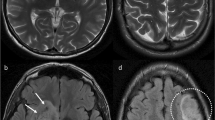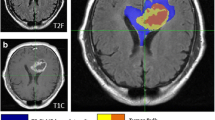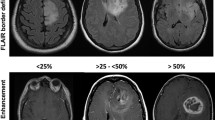Abstract
Introduction
Recent studies have identified that glioblastoma IDH-wildtype consists of different molecular subgroups with distinct prognoses. In order to accurately describe and classify gliomas, the Visually AcceSAble Rembrandt Images (VASARI) system was developed. The goal of this study was to evaluate the VASARI characteristics in molecular subgroups of IDH-wildtype glioblastoma.
Methods
A retrospective analysis of glioblastoma IDH- wildtype with comprehensive next-generation sequencing and pre-operative and post-operative MRI was performed. VASARI characteristics and 205 genes were evaluated. Multiple comparison adjustment by the Bejamin-Hochberg false discovery rate (BH-FDR) was performed. A 1:3 propensity score match (PSM) with a Caliper of 0.2 was done.
Results
178 patients with GBM IDH-WT met the inclusion criteria. 4q12 amplified patients (n = 20) were associated with cyst presence (30% vs. 12%, p = 0.042), decreased hemorrhage (35% vs. 62%, p = 0.028), and non-restricting/mixed (35%/60%) rather than restricting diffusion pattern (5%), meanwhile, 4q12 non-amplified patients had mostly restricting (47.4%) rather than a non-restricting/mixed diffusion pattern (28.4%/23.4%). This remained statistically significant after BH-FDR adjustment (p = 0.002). PSM by 4q12 amplification showed that diffusion characteristics continued to be significantly different. Among RB1-mutant patients, 96% had well-defined enhancing margins vs. 70.6% of RB1-WT (p = 0.018), however, this was not significant after BH-FDR or PSM.
Conclusions
Patients with glioblastoma IDH-wildtype harboring 4q12 amplification rarely have restricting DWI patterns compared to their wildtype counterparts, in which this DWI pattern is present in ~ 50% of patients. This suggests that some phenotypic imaging characteristics can be identified among molecular subtypes of IDH-wildtype glioblastoma.


Similar content being viewed by others
Data availability
The datasets generated during and/or analyzed during the current study are available from the corresponding authors upon reasonable request.
Code availability
Not applicable.
References
Ostrom QT, Price M, Neff C et al (2022) CBTRUS Statistical Report: primary brain and other Central Nervous System tumors diagnosed in the United States in 2015–2019. Neuro Oncol 24:v1–v95. https://doi.org/10.1093/neuonc/noac202
Dono A, Ramesh AV, Wang E et al (2021) The role of RB1 alteration and 4q12 amplification in IDH-WT Glioblastoma. https://doi.org/10.1093/noajnl/vdab050. Neurooncol Adv
Reardon DA, Brandes AA, Omuro A et al (2020) Effect of Nivolumab vs Bevacizumab in patients with recurrent Glioblastoma the CheckMate 143 phase 3 Randomized Clinical Trial. 5450:1–8. https://doi.org/10.1001/jamaoncol.2020.1024
Karschnia P, Dono A, Young JS et al (2023) Prognostic evaluation of re-resection for recurrent glioblastoma using the novel RANO classification for extent of resection: a report of the RANO resect group. Neuro Oncol. https://doi.org/10.1093/neuonc/noad074
Yan H, Parsons DW, Jin G et al (2009) IDH1 and IDH2 mutations in Gliomas. N Engl J Med 360:765–773. https://doi.org/10.1056/NEJMoa0808710
Brennan CW, Verhaak RGW, McKenna A et al (2013) The somatic genomic Landscape of Glioblastoma. Cell 155:462–477. https://doi.org/10.1016/j.cell.2013.09.034
Eckel-Passow JE, Lachance DH, Molinaro AM et al (2015) Glioma groups based on 1p/19q, IDH, and TERT promoter mutations in tumors. N Engl J Med 372:2499–2508. https://doi.org/10.1056/NEJMoa1407279
Louis DN, Perry A, Wesseling P et al (2021) The 2021 WHO classification of tumors of the central nervous system: a summary. Neuro Oncol 23:1231–1251. https://doi.org/10.1093/neuonc/noab106
Diplas BH, He X, Brosnan-Cashman JA et al (2018) The genomic landscape of TERT promoter wildtype-IDH wildtype glioblastoma. Nat Commun 9:1–11. https://doi.org/10.1038/s41467-018-04448-6
Galbraith K, Kumar A, Abdullah KG et al (2020) Molecular correlates of Long Survival in IDH-Wildtype Glioblastoma cohorts. 79:843–854. https://doi.org/10.1093/jnen/nlaa059
Wangaryattawanich P, Hatami M, Wang J et al (2015) Multicenter imaging outcomes study of the Cancer Genome Atlas glioblastoma patient cohort: imaging predictors of overall and progression-free survival. Neuro Oncol 17:1525–1537. https://doi.org/10.1093/neuonc/nov117
Gutman DA, Cooper LAD, Hwang SN et al (2013) MR imaging predictors of molecular profile and survival: multi-institutional study of the TCGA glioblastoma data set. Radiology 267:560–569. https://doi.org/10.1148/radiol.13120118
VASARI Research Project. https://wiki.cancerimagingarchive.net/display/Public/VASARI+Research+Project
Harris PA, Taylor R, Minor BL et al (2019) The REDCap consortium: building an international community of software platform partners. J Biomed Inform 95:103208. https://doi.org/10.1016/j.jbi.2019.103208
Dono A, Wang E, Lopez-Rivera V et al (2020) Molecular characteristics and clinical features of multifocal glioblastoma. J Neurooncol 148. https://doi.org/10.1007/s11060-020-03539-z
Esquenazi Y, Friedman E, Liu Z et al (2017) The survival advantage of Supratotal Resection of Glioblastoma using selective cortical mapping and the subpial technique. Neurosurgery 81:275–288. https://doi.org/10.1093/neuros/nyw174
Chavhan GB, AlSabban Z, Babyn PS (2014) Diffusion-weighted imaging in Pediatric Body MR Imaging: principles, technique, and emerging applications. Radiographics 34:E73–E88. https://doi.org/10.1148/rg.343135047
Frampton GM, Fichtenholtz A, Otto GA et al (2013) Development and validation of a clinical cancer genomic profiling test based on massively parallel DNA sequencing. Nat Biotechnol 31:1023–1031. https://doi.org/10.1038/nbt.2696
Schwaederle M, Krishnamurthy N, Daniels GA et al (2018) Telomerase reverse transcriptase promoter alterations across cancer types as detected by next-generation sequencing: a clinical and molecular analysis of 423 patients. Cancer 124:1288–1296. https://doi.org/10.1002/cncr.31175
Dono A, Mitra S, Shah M et al (2021) PTEN mutations predict benefit from tumor treating fields (TTFields) therapy in patients with recurrent glioblastoma. J Neurooncol 153:153–160. https://doi.org/10.1007/s11060-021-03755-1
Dono A, Amsbaugh M, Martir M et al (2021) Genomic alterations predictive of response to radiosurgery in recurrent IDH-WT glioblastoma. J Neurooncol. https://doi.org/10.1007/s11060-020-03689-0
Kanda Y (2013) Investigation of the freely available easy-to-use software ‘EZR’ for medical statistics. Bone Marrow Transplant 48:452–458. https://doi.org/10.1038/bmt.2012.244
Stupp R, Mason WP, van den Bent MJ et al (2005) Radiotherapy plus Concomitant and Adjuvant Temozolomide for Glioblastoma. N Engl J Med 352:987–996. https://doi.org/10.1056/NEJMoa043330
Zhou H, Vallières M, Bai HX et al (2017) MRI features predict survival and molecular markers in diffuse lower-grade gliomas. Neuro Oncol 19:862–870. https://doi.org/10.1093/neuonc/now256
Park YW, Han K, Ahn SS et al (2018) Prediction of IDH1-mutation and 1p/19q-codeletion status using preoperative MR imaging phenotypes in lower grade gliomas. Am J Neuroradiol 39:37–42. https://doi.org/10.3174/ajnr.A5421
Jain R, Johnson DR, Patel SH et al (2020) Real world use of a highly reliable imaging sign: T2-FLAIR mismatch for identification of IDH mutant astrocytomas. Neuro Oncol 1–8. https://doi.org/10.1093/neuonc/noaa041
Booth TC, Williams M, Luis A et al (2020) Machine learning and glioma imaging biomarkers. Clin Radiol 75:20–32. https://doi.org/10.1016/j.crad.2019.07.001
Peeken JC, Hesse J, Haller B et al (2018) Semantic imaging features predict disease progression and survival in glioblastoma multiforme patients. Strahlenther Onkol 194:580–590. https://doi.org/10.1007/s00066-018-1276-4
Mazurowski MA, Desjardins A, Malof JM (2013) Imaging descriptors improve the predictive power of survival models for glioblastoma patients. Neuro Oncol 15:1389–1394. https://doi.org/10.1093/neuonc/nos335
Drake LR, Hillmer AT, Cai Z (2020) Approaches to PET imaging of glioblastoma. Molecules 25. https://doi.org/10.3390/molecules25030568
Karschnia P, Young JS, Dono A et al (2023) Prognostic validation of a new classification system for extent of resection in glioblastoma: a report of the RANO resect group. Neuro Oncol 25:940–954. https://doi.org/10.1093/neuonc/noac193
Romano A, Palizzi S, Romano A et al (2023) Diffusion weighted imaging in Neuro-Oncology: Diagnosis, post-treatment changes, and advanced Sequences-An updated review. Cancers (Basel) 15. https://doi.org/10.3390/cancers15030618
Svolos P, Kousi E, Kapsalaki E et al (2014) The role of diffusion and perfusion weighted imaging in the differential diagnosis of cerebral tumors: a review and future perspectives. Cancer Imaging 14:20. https://doi.org/10.1186/1470-7330-14-20
Gaddamanugu S, Shafaat O, Sotoudeh H et al (2022) Clinical applications of diffusion-weighted sequence in brain imaging: beyond stroke. Neuroradiology 64:15–30. https://doi.org/10.1007/s00234-021-02819-3
Wang Q-P, Lei D-Q, Yuan Y, Xiong N-X (2020) Accuracy of ADC derived from DWI for differentiating high-grade from low-grade gliomas: systematic review and meta-analysis. Medicine 99:e19254. https://doi.org/10.1097/MD.0000000000019254
Ikeda K, Kolakshyapati M, Takayasu T et al (2022) Diffusion-weighted imaging-gadolinium enhancement mismatch sign in diffuse midline glioma. Eur J Radiol 147:110103. https://doi.org/10.1016/j.ejrad.2021.110103
Holtkamp N, Ziegenhagen N, Malzer E et al (2007) Characterization of the amplicon on chromosomal segment 4q12 in glioblastoma multiforme. Neuro Oncol 9:291–297. https://doi.org/10.1215/15228517-2007-009
Bleeker FE, Molenaar RJ, Leenstra S (2012) Recent advances in the molecular understanding of glioblastoma. J Neurooncol 108:11–27. https://doi.org/10.1007/s11060-011-0793-0
Hamberg P, Verweij J, Sleijfer S (2010) (Pre-)Clinical pharmacology and activity of Pazopanib, a novel multikinase angiogenesis inhibitor. Oncologist 15:539–547. https://doi.org/10.1634/theoncologist.2009-0274
Burford A, Little SE, Jury A et al (2013) Distinct phenotypic differences Associated with Differential amplification of receptor tyrosine kinase genes at 4q12 in Glioblastoma. PLoS ONE 8. https://doi.org/10.1371/journal.pone.0071777
Chi AS, Sorensen AG, Jain RK, Batchelor TT (2009) Angiogenesis as a therapeutic target in malignant gliomas. Oncologist 14:621–636. https://doi.org/10.1634/theoncologist.2008-0272
Joensuu H, Puputti M, Sihto H et al (2005) Amplification of genes encoding KIT, PDGFRα and VEGFR2 receptor tyrosine kinases is frequent in glioblastoma multiforme. J Pathol 207:224–231. https://doi.org/10.1002/path.1823
Nobusawa S, Stawski R, Kim YH et al (2011) Amplification of the PDGFRA, KIT and KDR genes in glioblastoma: a population-based study. Neuropathology 31:583–588. https://doi.org/10.1111/j.1440-1789.2011.01204.x
Meyer H-J, Wienke A, Surov A (2019) Association between VEGF expression and diffusion weighted imaging in several Tumors-A systematic review and Meta-analysis. Diagnostics (Basel) 9. https://doi.org/10.3390/diagnostics9040126
Zhang L, Cheng C, Li B et al (2022) Combined clinical features and MRI parameters for the prediction of VEGFR2 in hepatocellular carcinoma patients. Front Oncol 12:961530. https://doi.org/10.3389/fonc.2022.961530
Wang Y, Wang K, Li H et al (2015) Identifying the association of contrast enhancement with vascular endothelia growth factor expression in anaplastic gliomas: a volumetric magnetic resonance imaging analysis. PLoS ONE 10:e0121380. https://doi.org/10.1371/journal.pone.0121380
Sun Z, Li Y, Wang Y et al (2019) Radiogenomic analysis of vascular endothelial growth factor in patients with diffuse gliomas. Cancer Imaging 19:68. https://doi.org/10.1186/s40644-019-0256-y
Beig N, Patel J, Prasanna P et al (2018) Radiogenomic analysis of hypoxia pathway is predictive of overall survival in Glioblastoma. Sci Rep 8:7. https://doi.org/10.1038/s41598-017-18310-0
Kickingereder P, Götz M, Muschelli J et al (2016) Large-scale Radiomic Profiling of Recurrent Glioblastoma identifies an imaging predictor for stratifying anti-angiogenic treatment response. Clin Cancer Res 22:5765–5771. https://doi.org/10.1158/1078-0432.CCR-16-0702
Acknowledgements
None.
Funding
Research reported in this publication was supported by the National Cancer Institute of the National Institutes of Health under Award Number K08CA241651 (LYB). The content is solely the responsibility of the authors and does not necessarily represent the official views of the National Institutes of Health.
Author information
Authors and Affiliations
Contributions
Study design: A.D., Y.E. Data collection: A.D., L.N., O.A., J.C.RQ. Data analysis: A.D., J.T., Manuscript draft writing: A.D., J.T., L.N. Manuscript editing: A.D., L.N., O.A., R.F.R., A.K., N.T., L.Y.B., Y.E. Manuscript approval: all authors.
Corresponding author
Ethics declarations
Conflict of interest
No conflicts of interest were reported by the authors.
Ethics declaration
This study was approved by the institutional review board of The University of Texas Health Science Center at Houston and Memorial Hermann Hospital, Houston, TX and it was in accordance with the 1964 Helsinki Declaration and its later amendments.
Consent to participate and publication
Not applicable.
Competing interests
The authors declare no competing interests.
Additional information
Publisher’s Note
Springer Nature remains neutral with regard to jurisdictional claims in published maps and institutional affiliations.
Electronic supplementary material
Below is the link to the electronic supplementary material.
Rights and permissions
Springer Nature or its licensor (e.g. a society or other partner) holds exclusive rights to this article under a publishing agreement with the author(s) or other rightsholder(s); author self-archiving of the accepted manuscript version of this article is solely governed by the terms of such publishing agreement and applicable law.
About this article
Cite this article
Dono, A., Torres, J., Nunez, L. et al. Imaging predictors of 4q12 amplified and RB1 mutated glioblastoma IDH-wildtype. J Neurooncol 167, 99–109 (2024). https://doi.org/10.1007/s11060-024-04575-9
Received:
Accepted:
Published:
Issue Date:
DOI: https://doi.org/10.1007/s11060-024-04575-9




